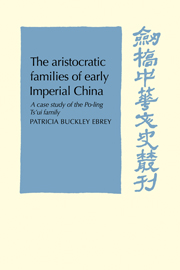Book contents
- Frontmatter
- Contents
- List of tables
- Acknowledgements
- Chronology of the Chinese dynasties
- 1 Introduction
- 2 The historical development of the aristocratic families
- 3 Origins of the Ts'uis in the Han
- 4 The Ts'uis in the aristocratic age
- 5 The Ts'uis as an old family in the T'ang
- 6 Implications and conclusions
- Notes to the text
- Appendix I The reliability of the genealogical tables in the Hsin T'ang shu
- Appendix II Annotated genealogy of the descendants of Ts'ui Yen, d. 646
- Appendix III Marriages of Po-ling Ts'uis during the T'ang
- Bibliography
- Glossary
- Index
Appendix I - The reliability of the genealogical tables in the Hsin T'ang shu
Published online by Cambridge University Press: 04 August 2010
- Frontmatter
- Contents
- List of tables
- Acknowledgements
- Chronology of the Chinese dynasties
- 1 Introduction
- 2 The historical development of the aristocratic families
- 3 Origins of the Ts'uis in the Han
- 4 The Ts'uis in the aristocratic age
- 5 The Ts'uis as an old family in the T'ang
- 6 Implications and conclusions
- Notes to the text
- Appendix I The reliability of the genealogical tables in the Hsin T'ang shu
- Appendix II Annotated genealogy of the descendants of Ts'ui Yen, d. 646
- Appendix III Marriages of Po-ling Ts'uis during the T'ang
- Bibliography
- Glossary
- Index
Summary
The genealogical tables in the Hsin T'ang shu (HTS) are the most extensive source available for the Po-ling Ts'uis in the T'ang. They list more Ts'uis than all other sources combined, and also have the advantage of indicating kinship relationships. Some scholars have relied heavily on these tables in their research of individual families and clans. Before using them in the present study, however, I decided to examine carefully the nature of these genealogical tables in order to assess fairly their limitations and reliability. This appendix, which examines these problems, has been written primarily for other scholars who have at some time tried to use these genealogical tables. Anyone else who wishes to follow the technical arguments presented here is advised first to examine the content of these tables.
To briefly review the format of the genealogical tables, the organizing principle in compiling them was that each of the almost 400 T'ang Chief Ministers be given a genealogy. These genealogies were then grouped according to surname, ninety-eight in all. The section for each surname starts with an account of its origins in the distant past, usually rather sketchy until the Han dynasty, and then if there were Chief Ministers of that surname from different lineages, an account of the branching of the surname was given. Next follow the tables, which have space for twelve generations. Many of the tables for large lineages begin in the fifth or sixth century and continue through the T'ang.
- Type
- Chapter
- Information
- The Aristocratic Families in Early Imperial ChinaA Case Study of the Po-Ling Ts'ui Family, pp. 157 - 178Publisher: Cambridge University PressPrint publication year: 1978

